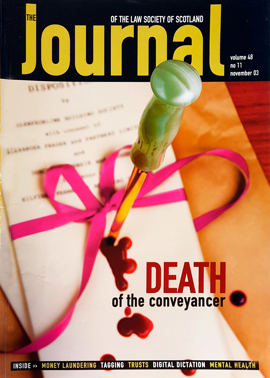Book reviews
The International Chamber of Commerce produces many superb publications which, alas, are too little known in Scotland. (Full details can be found at the ICC’s website: www.iccwbo.org). Preventing Financial Instrument Fraud is one such publication, and it deserves a particularly wide readership. This is real hands-on stuff, including reproductions of genuine fake documents (if such an expression is permissible), blow-by-blow accounts of actual financial frauds, and numerous tips about what to look out for, including impressive-sounding financial terms which are widely favoured by fraudsters. The plausibility of some of the sample documents is truly disturbing. This book is a state-of-the-art publication. At 128 pages it is not not cheap but it is in a class of its own.
George L Gretton
Subtitled “An exposition of the law governing the calculation of damages in personal injury cases”, this book is rather more than that. Published only two years after the second edition, it has attempted to keep up-to-date with the many developments in this area. Not as well known as McEwan & Paton or Kemp & Kemp, it covers the same areas as these excellent tomes and has enough features of its own to make it a worthwhile purchase for any lawyer.
It is necessary to have a firm foundation from which to work in the ever changing field of personal injury, and this book gives a solid basis for any lawyer who wants to know the general principles and would appreciate guidelines on the quantification of individual claims without having to buy a raft of individual texts and tables. It is a handy book but a lengthy one. Of the 746 pages, 650 are taken up by appendices which contain most of the raw material one would need to make an assessment of damages in every conceivable case.
The first part of the text covers the different types of award which can be made and sets out the law with ample citation of authority for those who wish to follow up the basic text. The second part addresses the law regarding the different heads of claim for personal injury and again the copious citation of authority in the footnotes points the way to a more detailed exposition. The third part covers heads of claim for death of a relative, and since this is an area which can cause considerable difficulty it is helpful to have the law explained succinctly in one relatively brief chapter. The book contains a note of the first instance judgment in the Shaher case, which is a testament to its contemporary content, although the appeal decision unfortunately came too late to be included.
The remainder of the book consists of five major appendices: the Ogden Tables, a style of structured settlement, the current Judicial Studies Board Guidelines (6th edition), reported cases on awards for non-pecuniary losses (solatium), and reported cases for awards in pecuniary losses, including earnings and services. The reported PI cases in the last two appendices, which together run to 470 pages, are not categorised very clearly. There are brief summaries of many cases dealing with damages and reported mostly in the Scots Law Times, in chronological order from 1983 to 2002. There is a helpful index with the amounts of the awards updated for inflation. This is an extremely useful segment of the book for those who know their way around personal injury claims, but it might be difficult to navigate for the novice.
This is a “one-stop” source of material which would be well worth having in any personal injury library.
Charles Hennessy
In this issue
- Big wheels keep on turning
- Outsourcing: trick or treat?
- The end of conveyancing as we know it
- A conflict of interest
- You’re tagged
- The beginning of the end
- The Scottish Law Commission’s Trust Law Review
- Disclosure: divorce lawyers and proceeds of crime
- Talking digital
- Keep an eye on your fee-earners
- Dot.com survivor!
- Determining place of payment
- Mental Health Act: care and treatment
- Affidavits in undefended divorces
- Scottish Solicitors’ Discipline Tribunal
- Jury trials in the Court of Session
- Website reviews
- Book reviews
- Preserving superiors’ rights
- Housing Improvement Task Force
- Land certificates: could this be yours?






